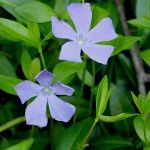| Common Name: |
Lesser Periwinkle |
| Botanical Name: |
Vinca Minor |
| Genus: |
Vinca |
| Family: |
Apocynaceae |
| Native Location: |
Europe, S Russia, and the N Caucasus. |
| Cultivation: |
Moist soil in sun or partial shade. Invasive. Cut back plants in autumn or winter to control spread. Remove excess shoots in summer to restrict spread before rooting at nodes takes place. Leaves may be damaged by rust. |
| Propagation: |
By division from autumn to spring; by semi-ripe cuttings in summer. |
| Harvest: |
Plants are cut when flowering and processed commercially for alkaloid extraction, or dried for use in infusions, liquid extracts, powders and tinctures. |
| Variations: |
Alba Variegata
Syn. Alba Aureavariegata
Has white flowers and yellow-marginated leaves. |
Argenteovarigata
Syn. Variegata
Has pale violet-blue flowers and cream-margined leaves. |
Atropurpurea
Syn. 'Purpurea', 'Rubra'
Has purple flowers. |
Azurea Flore Pleno
Syn. Caerulea Plena
Has double blue flowers. |
Gertrude Jekyll
Is compact, with numerous white flowers. |
La Grave
Syn. 'Bowles' Blue', 'Bowles' Variety'
Bear large lavender-blue flowers. |
Multiplex
Syn. Double Burgundy
Bear doubles purple flowers. |
|
| Height: |
10-20cm (4-8in) |
| Width: |
Indefinite |
| Hardiness: |
Z4-9 |
| Parts Used: |
Leaves |
| Properties: |
A bitter, astringent herb that controls bleeding and discharges, and improves blood flow to the brain. |
| Medicinal Uses: |
Internally for heavy menstruation, internal hemorrhage, nosebleed, arteriosclerosis, and dementia caused by reduced blood flow to the brain. Externally for sore throat, gum inflammation, and mouth ulcers. Combined with Trillium erectum (See, Bethroot) for menstruation with Ginkgo biloba (See, Ginkgo for hardening of the cerebral arteries. |
| Warning: |
Toxic if eaten.
Contraindicated during pregnancy. |
| Bibliography: |
The Encyclopedia of Herbs by Deni Bown Copyright © 1995, 2001 Dorling Kindersley Limited. pp 404-405
|
